|
|
 |
Fiche d'espèce de Copépode |
|
|
Calanoida ( Ordre ) |
|
|
|
Clausocalanoidea ( Superfamille ) |
|
|
|
Aetideidae ( Famille ) |
|
|
|
Euchirella ( Genre ) |
|
|
| |
Euchirella lisettae Vaupel Klein, 1989 (F) | |
| | | | | | | Syn.: | Euchirella bella (F) : C. B. Wilson, 1950 (p.218, figs.F);
Euchirella sp. C Vaupel Klein, 1984 a (p.49, Table II: characters, Rem.) | | | | Ref.: | | | Vaupel Klein, 1989 (p.146, Descr.F, figs.F) | 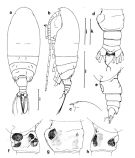 issued from : J.C. von Vaupel Klein in Monoculus, 1992, 24. [p.21, Fig.1]. Female (20°29'S, 103°26'W): a, habitus (dorsal view); b, idem (left lateral aspect); c, anterior part of head with rostrum (left); d, e, urosome (dorsal, left, respectively); f, genital somite, with internal structures for sperm storage (left, dorsal, right, respectively). Scale: i = 1.0 mm for a, b; j = 0.5 mm for c, e; k = 0.5 mm for d; l = 0.5 mm for f, g, h. Nota Female: - Cephalothorax ovoid and a short, compressed urosome. - Head and 1st pedigerous segment almost completely fused (line of fusion very faint in both dorsal and lateral view, and only apparent in the middorsal region; pediger segments 4 and 5 fused. - Posterolateral corners of the last thoracic segment rounded. - Pediger segments 2, 3 and 4+5 equipped with 1, 4, and 5 (= 1+4) hair sensilla, respectively, on either side. - Relative lengths of cephalothoracic somites (measured along middorsal line) 69 : 9 : 9 : 13 = 100. - Forehead smoothly rounded, without crest. - Frontal organ just visible in dorsal view. - Rostrum relatively short, single-pointed, acute and hardly curved. - Urosome 4-segmented; relative lengths (caudal rami included) 45 : 18 : 15 : 12 : 10 = 100. - Genital segment asymmetrical in its dorsal half; on the right there is a small dorso-lateral swelling, more or less in the form of a slightly protruding ridge; left margin strongly vaulted by an anterolaterally directed outgrowth (which accommodates both left and right seminal receptacles); this outgrowth is also distinct in lateral aspect but it hardly protrudes dosrsally (apparently, the right receptacle has moved via a latero-dorsal track to the left, where it has settled in a dorso-medial position relative to the left receptacle, which is situated more ventrally). The ventral outline is rather straight, with the genital prominence hardly protruding. - Anal somite short and compressed, bearing a broadly rounded anal operculum. - Caudal rami dorso-ventrally fattened, more or less squarish in dorsal view; both rami bear a ventro-medially projecting brush of long hairs on their medial face, and with 6 setae: the curved , strongly feathered ventro-medial seta; the markedly reduced, almost spiniform smooth lateral seta, and 4 large, articulating caudal setae; of these, the 2nd seta from lateral is slightly longer than the other 3, which are subequal length.; all 4 large setae exhibit the presence of a distal articulation site, at c. 0.30 the length of the inner and outermost seta, while in the intermediate ones this site is situated at c. 0.40 along their length; all large setae are setulose, either completely or at least to a large extent.
|
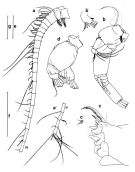 issued from : J.C. von Vaupel Klein in Monoculus, 1992, 24. [p.23, Fig.2]. Female: a, a', left A1 (lateral view), aesthetascs on segments 5 and 8+9 drawn from right A1; b, right A2 (medial aspect); b', idem (detail of endopod 2+3; c, masticatory edge of right Md (posterior view), the dorso-medial section (dashed lines) has been drawn from paratype; c', idem (detail of multicuspidate molariform complex of left Md (posterior view); d, palp of right Md (posterior aspect). Scale: e = 0.5 mm for a, a'; f = 0.5 mm for b, 0.25 mm for b', 0.2 mm for c, c'; g = 0.2 mm for d.
Nota Female: - A1 24-segmented, reaching to halfway anal segment; segments 8 and 9, 25and 26 fully coalesced, with remnants of former sutures beiing only fainty indicated; segment 2 represents the usual complex of 3 previously independant segments. - A2 endopod strongly reduced, endopod/exopod ratio c. 0.25. The two segments of basipod largely fused, this complex bears 1 large, plumose seta, a dense brush of long hairs, and 1 short, weakly developed hairbrush. At the base of endopod, 1 short seta; endopod 2-segmented, 1st segment with 1 small seta in subapical position; distal segment with 5 + 5 setae on the proximal and terminal lobes, respectively, the larger ones are sparsely plumose; the setae on the terminal lobe are much longer than those on the proximal lobe, the terminal lobe is also equipped with a subapical row of 4-6 well developed spinules. Exopod 6-segmented; segments 1 and 2 fused to form a long cylindrical structure, remnants of a suture hardly discernible; segments 3 to 6 free, each armed with 1 large plumose seta; the 7th segment of exopod is again long and cylindrical, 3 large, plumose setae insert terminally and there is a small lobular outgrowth situated medially, in front of their bases. - Md with gnathobase heavily chitinized structure; masticatory edge composed of 5 groups of teeth: there is a multicuspidate molariform complex proximally, which includes a large, spinulose setiform tooth and a smaller, serrate setiform tooth; next, there are 3 bicuspidate molariform teeth of about equal size (at least 2 of which show a setiform projection, in their central depression); A lage, monocuspidate molariform tooth terminates the masticatory edge distally. The palp comprises the distal segments, including the annular sclerite that forms the junction with the gnathal part; basipodal segment 2 smooth, without setae or spinules; the connection of basipodal segment 2 with endopodal segment 1 is intimate, the sclerites being fused to a considerable extent; the articulation between the two segments of the endopod appears to be largely free; endopodal segment 1 may show the vestige of a seta, but this structure is not apparent in every specimen; endopodal segment 2 bears an apical row of 9 setae, 1-3 consecutively stronger, 4-7 all well developed, 8 situated on a distinct pedestal, and seta 9 slender and more weakly developed; all setae of endopodal segment 2 are plumose. Exopodite apparently articulates freely with basipodal segment 2; this originally 6-segmented ramus has largely fused to form a single complex bearing 6 strong, plumose setae, inserting along the postero-medial edges of its former segments.
|
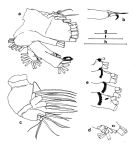 issued from : J.C. von Vaupel Klein in Monoculus, 1992, 24. [p.25, Fig.25]. Female: a, left Mx1 (posterior face); b, right Mx1 (detail of endite of basipod 2) (anterior aspect), hairbrush not shown; c, right Mx2 (antero-ventral view); d, left Mx2 (detail of endite 5 and terminal part of appendage); e, left Mx2 (postero-medial view), detail of spinular pectines on endites 1-4. Scale: f = 0.2 mm for a; g = 0.005 mm for b, 0.2 mm for c; h, 0.2 mm for d, e. Nota Female: - Mx1 with the 1st inner lobe bearing 7 heavy, bipectinate/spinulose setae along its edge, plus 2 long, spinulose ones; there is 1 small appendicular seta, submarginally on the anterior face, the posterior side is equipped with 2 setae, inserting at close range: these are the nos. 1 and 2 of the original complement of 4 setae. The 2nd inner lobe has 3 apical setae, the 2 posterior ones combined bipectinate and spinulose, the single anterior seta spinulose only; the 1st outer lobe has a marginal row of 8 plumose setae, the no. 5 from proximal being weakly developed; the 2nd outer lobe is absent (as in all Euchirella species. Basis (basipodal segment 2) bears 1 large and 2 small setae subapically, the large one finely bipectinate and coarsely spinulose, the small setae finely plumose only; the proximal edge of this segment is fringed with a sparse row of hairs; the armature of the endite is strongly reduced, though the terminal, blunt tooth with its pore-like apex normally developed; the central and the distal setae are very short and weakly developed, the latter may even be absent altogether in some specimens; the apical half of the endite is furnished with an extensive patch of long hairs. The well-delimited endopod bears 4 normally developed setae, all combined bipectinate and spinulose. Exopod partly fused to basis, bears a marginal row of 10 slender, plumose setae; the seta in the distalmost position, no. 11, through strongly reduced aooears to have been retained in most cases in an almost vestigial form, its presence , however, could not be ascertained in all specimens examined; there is a small brush of short hairs on the distal edge of this segment. - Mx2 short and compressed, basipodal segment 1 smooth, without warts adjacent to the arched lateral margin; this segment bears the usual 4 endites, each equipped with 3 setae; basipodal segment 2 with 1 endite which bears 3 setae of unequal development, the two smaller ones correspond in structure to those of the type-species; the small and largely fused endopod bears 3 moderately large setae corresponding to its former segments 1-3, 3 slender apical setae referable to endopodal segment 4 and 2 small vestigial setae; the hook-shaped outgrowth on endite 1 appears rather blunt; the endites 1-4 bear spinular pectines on their posteromedial faces, composed of respectively, c.9 (range 8-10), c. 35 (27-43), c. 30 (28-33), and c. 38 (35-40) elements; on the endite 4, there often is a small accessory patch of c. 7 (range 6-14) spinules, inserting in a single, close bush, situated between the regular comb and the basis of the short and thick seta on that lobe; the small patch of spinules on the endite 5 appears to be absent in this species.
|
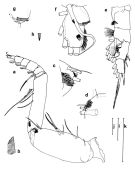 issued from : J.C. von Vaupel Klein in Monoculus, 1992, 24. [p.27, Fig.4]. Female: a, right Mxp (medial view); b, idem (detail of comb of spinules on basipod 2; c, patch of spinules on disto-medial corner of basipod 1 (lateral aspect); d, same detail as in (c), left appendage, lateral view); e, left P1 (anterior view); f, idem (detail of endopod 1 and curved seta of basipod 2; g, idem (detail of subapical row of spinules on tubercule, swowing also adjacent region with thin integument and large pores); h, idem (detail of brush of six central hairs). Scale: i = 0.2 mm for a, 0.1 mm for f; j = 0.05 mm for b, c, g, h; k = 0.5 mm for e. Nota Female: - Mxp characteristically curved, comprise 2 basipodal segments and 5 endopodal segments; with relative lengths 38 : 42 : 3 : 6 : 4 : 5 : 2 = 100. Basipodal segment 1 with 4 groups of setae, normally developed, along the anterior edge; the anterodistal corner of the segment bears a brush of thin hairs apico-medially, and a field of short, stout spinules apico-laterally, comprising c. 40-60 elements. Basipodal segment 2 long and slender; along its posterior edge are 3 slender setae, one long, combined bipectinate and spinulose, and 2 shorter ones bipectinate only; distally, the segment bears 2 more setae, one long, combined multipectinate/plumose , the other being the short and relatively blunt, specialized bipectinate seta usually present at this site in Euchirella. The proximal comb of spinules on the medial face of this segment is composed of c. 16 (15-17) rather long and slender elements (fig.4b) placed in a single, contiguous row. The setal arrangement of endopod includes 4 setae in the postero-distal corner of endopodal segment 1, 3 on both endopodal segments 2 and 3 as well as on the endopodal segment 4; this last segment also bears the small and smooth appendicular seta inserting at the anterior edge; endopodal segment 5 has 4 terminal setae, the appendicular one in this case inserting directly adjacent to the regular arrangement of three
|
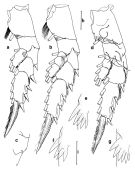 issued from : J.C. von Vaupel Klein in Monoculus, 1992, 24. [p.29, Fig.5]. Female: a, left P2 (anterior aspect); b, left P3 (anterior); c, idem (detail of right appendage (posterior view) showing disto-lateral spinular outgrowth on basipod 2; d, right P4 (posterior); e, idem (detail of five spines on basipod 1; f, same four spines on left appendage (anterior view); g, paratype with six spines on basipod 1 of right P4 (posterior aspect) (the left P4 has five spines). Scale: h = 0.2 mm for a-d; i = 0.1 mm for e-g. Nota Female: - P1: coxa, basis, endopod 1-segmented, exopod 2-segmented; terminal spine of exopodal segment 3 with about 70 denticles. - P2: coxa, basi, endopod 1-segmented, exopod 3-segmented; terminal spine of exopodal segment 3 with about 21-22 denticles. - P3: coxa, basis, endopod 3-segmented, exopod 3-segmented; terminal spine of exopodal segment 3 with about 20-22 denticles. - P4: coxa, basis , endopod 3-segmented, exopod 3-segmented; coxa without medial hairbrush but usually 5 (range 4-6) stout, heavily chitinized spines on its posterior face, which share a common stalk and situated adjacent to the medial margin. The caudal face of coxa, basis and exopodal segment 1 is equipped with a number of well-developed hair-sensilla, viz. 4, 3 and 1 respectively. The serrate lateral edge of the terminal spine of exopodal segment 3 is composed of 22-24 denticles.
|
 issued from : C.B. Wilson in Bull. U.S. natn Mus., 100, 14 (4). [Pl.9, Fig.92-94]. As Euchirella bella. Female (from Pacific): 92-93, habitus (dorsal and lateral, respectively); 94, basipod of P4.
|
 issued from : C.B. Wilson in Bull. U.S. natn Mus., 100, 14 (4). [Pl.19, Figs.248, 261-265]. As Euchirella bella. Female: 248, basipod of P4; 261, A2; 262, Md; 263, Mxp; 264, P1; 265, P2.
|
 issued from : J.C. von Vaupel Klein in Monoculus, 1992, 24. [p.22]. Female A1: Relative lengths of the segments. - A1 24-segmented. Segments 8 and 9 fused and 25-26 fused. - Large articulating setae present on segments 2, 7, 8+9, 14, 16, 18, 21 (on each, in antero-distal position), on 22 (one disto-caudally), 23 (one caudally), 24 (one frontally and one caudally), on 26 (two terminal large setae). A single aesthetasc is found on each of segments 2, 5, 8+9, 12, 14, 19, and 25+26. A tuft of short and thin integumental hairs is present in the postero-distal corner of segments 1 to 7; segment 24, moreover, bears a hair-sensillum along its fronral edge inserting distad to the frontal seta.
| | | | | NZ: | 1 | | |
|
Carte de distribution de Euchirella lisettae par zones géographiques
|
| | | | Loc: | | | Pacif. (S & SE tropical), ? Philippines
Type locality: 20°29'S, 103°26' W. | | | | N: | 3 | | | | Lg.: | | | (241) F: 4,6-3,2; (1257) F: 3,8-4,0; {F: 3,20-4,60} | | | | Rem.: | For Vaupel Klein (1984 a, p.49)b this species is similar to E. bella. Differences include: (1) swelling on genital somite ear-shaped, on left, comprising both left and right receptacula selminis (vs. swelling smooth, on right, comprising right receptacle only, left one being poorly developed); (2) Number of subterminal spinules on A2Ri2 + 3 c. 4 (vs. none); (3) Basipod 2 of Mx1 with 2 large plus 1 small seta (vs. 1 + 1); (4) Basipod 1 of P4 with 5-6 spines originating from a common base (vs. 3-5, but normally 4). | | | Dernière mise à jour : 22/01/2021 | |
|
|
 Toute utilisation de ce site pour une publication sera mentionnée avec la référence suivante : Toute utilisation de ce site pour une publication sera mentionnée avec la référence suivante :
Razouls C., Desreumaux N., Kouwenberg J. et de Bovée F., 2005-2025. - Biodiversité des Copépodes planctoniques marins (morphologie, répartition géographique et données biologiques). Sorbonne Université, CNRS. Disponible sur http://copepodes.obs-banyuls.fr [Accédé le 05 janvier 2026] © copyright 2005-2025 Sorbonne Université, CNRS
|
|
 |
 |










